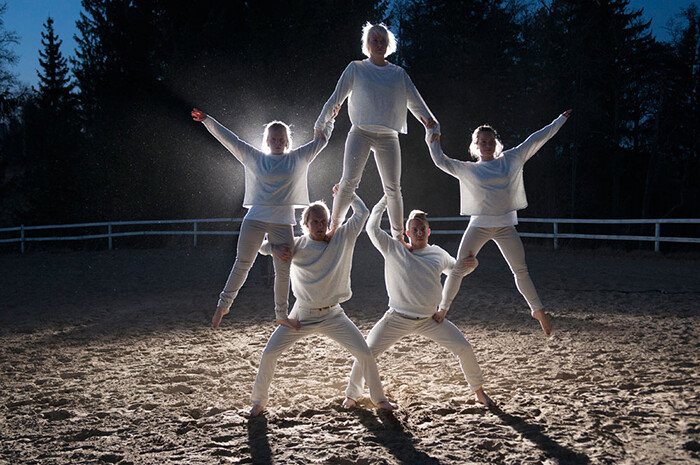Human beings are destroying the planet. If we want to save it we must therefore make inhuman art. Arguments to this effect seem to have enjoyed some currency in recent curatorial practice. Alas, Eija-Liisa Ahtila’s accomplished video installation at Galleri Charlotte Lund in Stockholm does not save the world, nor does it wish to. But it confronts us with some of the critical insufficiencies that also haunt the credulous environmentalism of the “non-anthropocentric” contingent.
The single work on display in the gallery, Studies on the Ecology of Drama 1 (2014), is essentially a filmed lecture, projected on four screens surrounding the centrally placed spectator. Watching the film is necessarily a fragmented experience, since only two or, at most, three screens can be seen at once. The film, says the protagonist Kati, a Finnish actor who guides us through its 27 minutes, explores “the living and the representation of living things.” Its starting point is “the human-centered perspective of cinema” and the way its stories “focus on humans.” It presents “exercises for change,” playing with the thought that it could be possible to “see differently.”
The main adversary in Ahtila’s work is therefore the mainstream fiction film, as embodied physically and institutionally by the traditional, single-screen cinematic apparatus. Studies shows the limitations of this monolithic model, and explores a series of possible alternatives. Of course, the multi-screen video setup itself challenges the spectatorship and narrative conventions of classical cinema. Ahtila employs this arrangement in a sequence of scenes that demonstrate how the perceptual systems of other species—birds, dogs, butterflies—create other worlds of experience. Her case for transcending human perception through a reconfiguration of the technologies of vision in a sense evokes some of the experiments of early cinema, but without the transformative social effects that were ascribed to the new artform by film theorist Ricciotto Canudo or art historian Élie Faure—or, for that matter, later, by Dziga Vertov.
In any case, Ahtila’s film is replete with memorable scenes. Slow-motion images show a happy, bearded man bouncing on a trampoline against the backdrop of a greenscreen. He appears to be floating in weightless bliss as the soundtrack soars with distorted guitars. This illustrates the phenomenology of the swift, whose rate of visual registration is higher than ours, so that, for the bird, the human world must look like an inert, torpid soup. Another sequence employs a strobe in order to demonstrate how various species perceive flickering lights differently. For a dog, we learn, the intermittent frames of cinema do not fuse into continuity, every film appearing instead as a Paul Sharits-like assault on the senses. The accompanying shots of an innocent, faithful retriever distantly communicate with Godard’s latest achievement, Goodbye to Language (2014), where a steadfast dog represents a refuge from the vain machinations of human relations. Needless to say, Ahtila also masters the multi-screen montage with characteristic dexterity and ease, the play of transitions, correspondences, and contrasts unceasingly calling our attention in new directions while coalescing into a coherent, spatio-temporal totality.
But a question remains, glaring, refusing to be dismissed: who cares about the human-centered perspective of the traditional cinematic apparatus? Why devote this energy to dismantling an anachronism? It’s like mounting a critique against the normalizing effects upon intellectual production of the codex book format. Surely intellectuals have worse things to worry about. The question has serious ramifications. The mainstream model of narrative film certainly remains in force, arguably more powerful than ever. But its dispersal across a plethora of screens and formats, and its integration in multiple interfaces and consumer technologies, in a way has already transcended the limits of human perception. This pervasive decentralization of the apparatus for mediating audiovisual commodities belongs to the wider process of colonizing and redeveloping the human lifeworld, creating ever new domains of exploitation and accumulation. The ultimate product of this process is a new mode of subjectivity, a form of life whose conditions are not determined according to the physical needs of the human species, but established by the demands of deregulated, globalized capital.
In the 1970s—when traditional cinema spectatorship entered into a state of crisis—Jean-Louis Baudry and Laura Mulvey analyzed the ideology of the basic cinematic apparatus and the patriarchal logic of its libidinal arrangement.1 Today, criticism turns against the anthropocentrism of contemporary cultural forms, and their alleged collusion in the man-made destruction of the biosphere. The “human” of this discourse is a straw man, diverting attention from the actual forces that, in the name of the health of the economy, ravage the world’s resources—and that are characterized precisely by their complete indifference to the conditions of existence of the vast majority of all living beings, human or not.
The lack of a true object of critique in Ahtila’s film—the one, admittedly not insignificant thing it can be reproached for—is apparent in one of its final sequences. In it, a group of theater students enact a short, rather corny lesson in biology. They climb up in trees and curl up in yellow sleeping bags, vaguely resembling chrysalides. In the following scene they then emerge into a field and jump around with cameras, awkwardly mimicking the fluttering behavior of butterflies. What if the human being could undergo a similar metamorphosis, and be released into a posthuman state of environmental harmony and beatitude? We should perhaps not stake our future on the hopes of such an ecological drama.
See Jean-Louis Baudry, “Ideological Effects of the Basic Cinematographic Apparatus,” in Narrative, Apparatus, Ideology: A Film Theory Reader (New York: Columbia University Press, 1986), and Laura Mulvey, “Visual Pleasure and Narrative Cinema” in Screen 16(3) (1975): 6–18.











